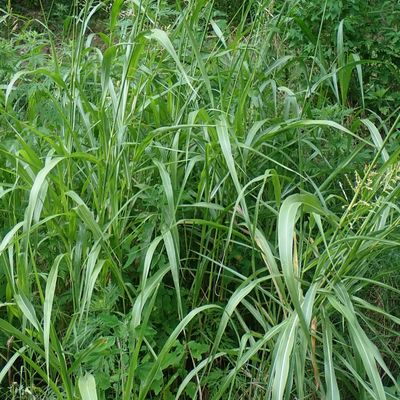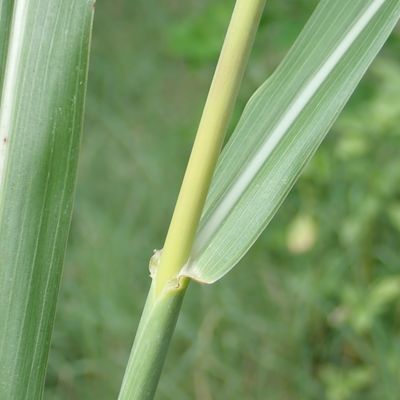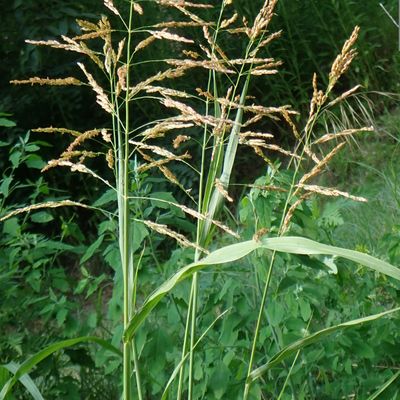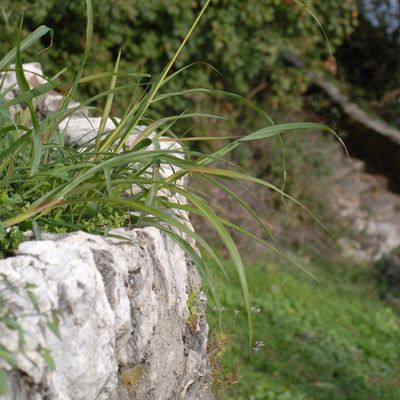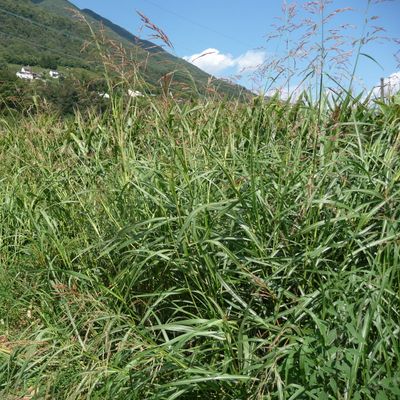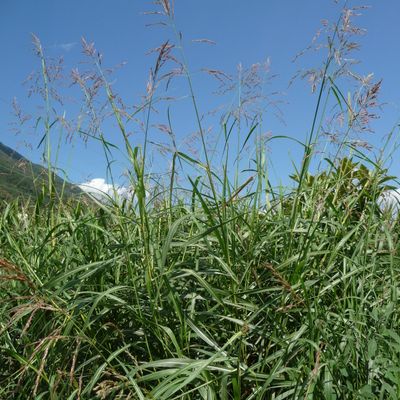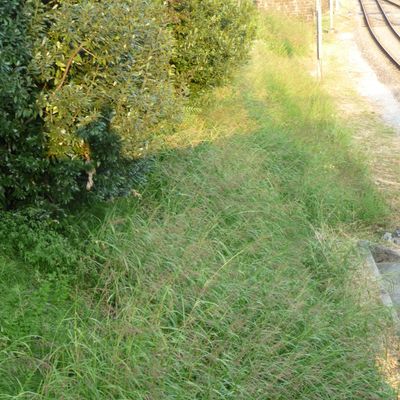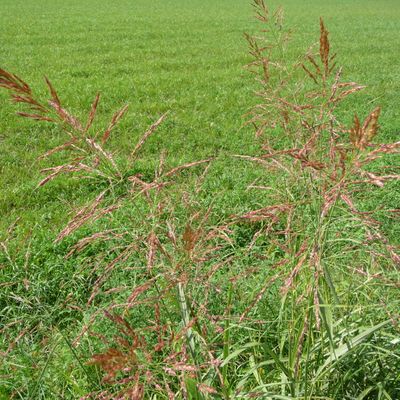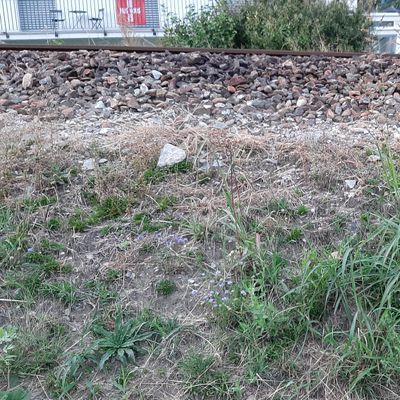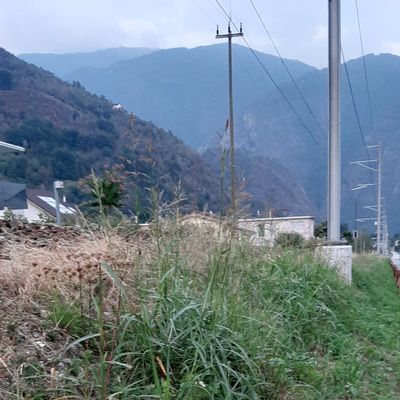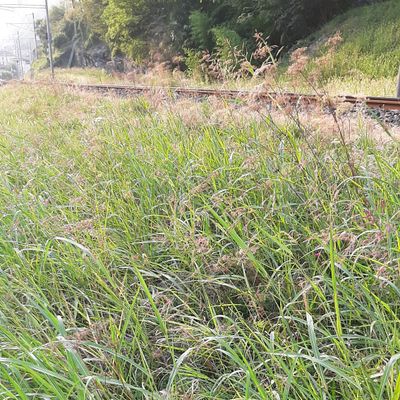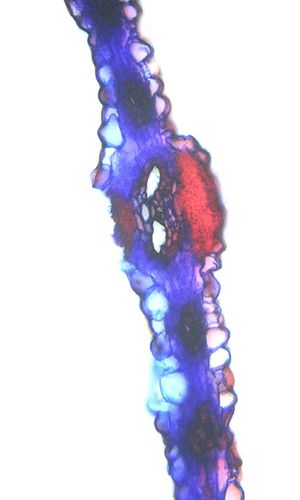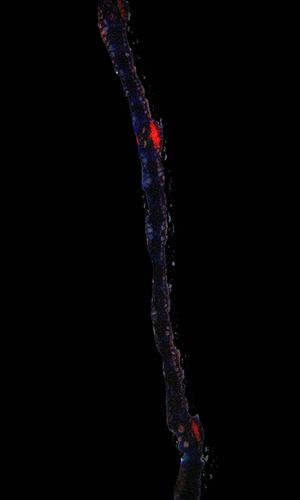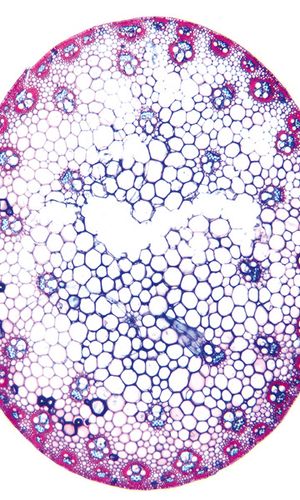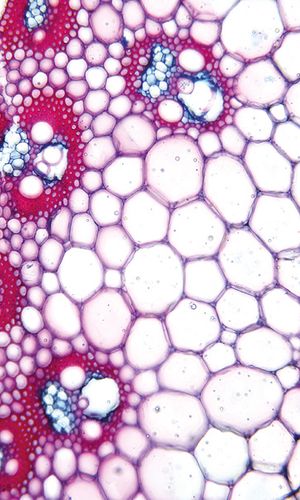Sorghum halepense (L.) Pers.
1044850
Species
ISFS : 402800
Checklist : 1044850
ISFS : 402800
Checklist : 1044850
Contains :
Synthesis
Species description (© Flora Helvetica 2018)
60-150(-200) cm hoch. Blätter 1-2 cm breit, glatt. Blatthäutchen bis 2 mm lang, behaart. Blütenstand eine bis 30 cm lange, lockere Rispe. Ährchen einblütig, 4-5 mm lang, gelb bis violett, weich behaart, die seitlichen zu 2, je ein sitzendes zwittriges und ein gestieltes männliches Ährchen, das zwittrige mit oder ohne feine Granne, das männliche stets unbegrannt. Hüllspelzen 3, länger als die Deckspelze.Flowering period (© Flora Helvetica 2018)
6-8Habitat and distribution inside Switzerland (© Flora Helvetica 2018)
Ödland, Schuttplätze / kollin / TI, sonst zerstreutWorld distribution (© Flora Helvetica 2018)
Ursprünglich ostafrikanisch-südwestasiatischEcological indicator (© Flora Helvetica 2018)
2w44-452.g.2n=40Status
IUCN status
flora.fl.National Priority
--International responsibility
--Conservation
Threats
Anatomy
Summary of leaf anatomy (German)
Obere Epidermiszellen gleich gross wie untere. Verbindungs-Steg zwischen oberer und unterer Epidermis aus verholzten und nicht verholzten Zellen. Leitbündel im Verbindungs-Steg in der Mitte eingebettet. Leitbündelhülle verholzt.Summary of stem anatomy (German)
Umriss rund oder oval. Leitbündel in mehreren Reihen. Epidermiszellen verholzt. Chlorenchyma in peripheren runden, ovalen oder rechteckigen Gruppen.Description
Culm-diameter 2-5 mm, center full, radius of culm in relation to wall thickness 1:1. Outline circular with a smooth surface. Culm-center full, containing unlignified cells. Epidermis- cells thin-walled all around. Large vascular bundles arranged in 2-3 peripheral rows. Chlorenchyma absent. Sclerenchyma in a large, peripheral continuous belt (> 3 cells). Cells medium thick-walled. Sclerenchymatic sheath around vascular bundles large, 3 to x cells. Largest vessels in vascular bundles in lateral position. Cavities (intercellulars) between parenchyma-cells present, small, often triangular. Distinct cavities (intercellulars) in the protoxylem area of vascular bundles.Distribution map
Habitat and distribution inside Switzerland
TI, sonst zerstreutWorld distribution
Ursprünglich ostafrikanisch-südwestasiatischEcology
Life form
Geophyte
Habitats
Milieux Phytosuisse (© Prunier et al. 2017)
Habitats © Delarze & al. 2015
 | 8.2.3.1 - Kalkarmer, lehmiger Hackfruchtacker (Polygono-Chenopodion) |
bold
Dominant species, influencing the appearance of the habitat
 Character species
Character species
 Less strictly linked to a specific habitat
Less strictly linked to a specific habitat
Ecological indicator values by © Landolt & al. (2010)
| Soil factors | Climatic factors | Salinity tolerance | |||
|---|---|---|---|---|---|
| Humidity Value H | 2w | Light Value L | 4 | Salinity Index | -- |
| Reaction Value R | 4 | Temperature factor T | 5 | ||
| Nutriments value N | 4 | Continentality K | 2 | ||
- Ecological values legend
Humidity Value H 1 very dry 1+ dry 2 moderatly dry 2+ moist 3 medium wet 3+ wet 4 very wet 4+ soggy 5 submerged or underwater f plants living in running water u mostly submerged plants v partly submerged, partly floating plants w humidity moderately variable (± scale of 1-2) w+ highly variable humidity (scale exceeding ± 2) Reaction Value R 1 Very acid (pH 2.5-5.5) 2 acid (pH 3.5-6.5) 3 lightly acid to neutral (pH 4.5-7.5) 4 neutral to basic (pH 5.5-8.5) 5 basic (pH 6-5 -> 8.5 Nutriments value N 1 very low in nutrients 2 low in nutriments 3 medium-poor to medium-rich in nutrients 4 rich in nutriments 5 very rich in nutriments Salinity tolerance 1 halotolerant 3 halophyle Light Value L 1 very shady 2 shady 3 lighted areas 4 luminous 5 highly luminous Temperature factor T 1 alpine to nival stages (from the treeline to the snowline) 1+ suprasubalpine and upper subalpine levels (pine and larch forests) 2 subalpine level (coniferous forests without beeches up to the upper limit of spruces) 2+ lower subalpine and upper mountain stages 3 mountain level (beech and silver fir forests, in the central Alps Scots pine forests) 3+ lower mountain and upper hill levels 4 hill level (mixed deciduous oak forests) 4+ hot places, hill level 5 very hot places, hill level (only in the hottest places, typical of southern Europe) Continentality K 1 Atlantic (high air humidity, very low temperature variations, mild winters) 2 Sub-Atlantic (high air humidity, low temperature variations, relatively mild winters) 3 sub-Atlantic to subcontinental (average air humidity, moderately variable temperature, slightly low winter temperatures) 4 subcontinental (low air humidity, large temperature variations, rather cold winters) 5 continental (very low air humidity, very large temperature variations, cold winters)
Water dependency
| Rivers | |
| Calm water | |
| Ground water |
Nomenclature
Accepted Name (Checklist 2017)
Sorghum halepense (L.) Pers.
Vernacular name
Deutscher Name :
Wilde Mohrenhirse, AleppohirseNom français :
Sorgho d'AlepNome italiano :
Sorgo selvatico, Sorgo d'AleppoMatch with other reference books
| Relation | Nom | Book | No |
|---|---|---|---|
| = | Sorghum halepense (L.) Pers. | Checklist 2017 | 402800 |
| = | Sorghum halepense (L.) Pers. | Flora Helvetica 2001 | 2805 |
| = | Sorghum halepense (L.) Pers. | Flora Helvetica 2012 | 2985 |
| = | Sorghum halepense (L.) Pers. | Flora Helvetica 2018 | 2985 |
| = | Sorghum halepense (L.) Pers. | Index synonymique 1996 | 402800 |
| = | Sorghum halepense (L.) Pers. | Landolt 1977 | 164 |
| = | Sorghum halepense (L.) Pers. | Landolt 1991 | 155 |
| = | Sorghum halepense (L.) Pers. | SISF/ISFS 2 | 402800 |
| = | Sorghum halepense (L.) Pers. | Welten & Sutter 1982 | 2359 |
= The taxon corresponds to the accepted taxon (Checklist 2017)
< The taxon is included in the accepted taxon (Checklist 2017)
> The taxon includes (among others) also the accepted taxon (Checklist 2017)
< The taxon is included in the accepted taxon (Checklist 2017)
> The taxon includes (among others) also the accepted taxon (Checklist 2017)
Status
Native status
-IUCN list of endangered species (© Walter & Gillett 1997) : No
Species from the "List of potentially invasive alien species"
Status on national Red List
| NO INFORMATION |
National Priority Species List Status
| National Priority | -- |
| Need to take action | -- |
| International responsibility | -- |
| Need to monitor populations | -- |
Protection status
| No international, national or cantonal protection |
- Disclaimer
InfoFlora compiles information on protected species as accurately as possible, taking it from the respective cantonal laws. In some cases, however, it was not possible to use the plant names as listed in the original text, but an interpretation of their taxonomy or nomenclature was necessary. The exact meaning of the categories „completely protected“ and „partially protected“ differs among the cantons.
InfoFlora cannot guarantee that the information on the protection status is correct and complete. In case of doubts, we recommend to look up the texts of the respective cantonal law.
Status by sector of activity
| Agriculture-related environmental objectives : | more informations | |
| Forest management environmental objectives : | more informations |

